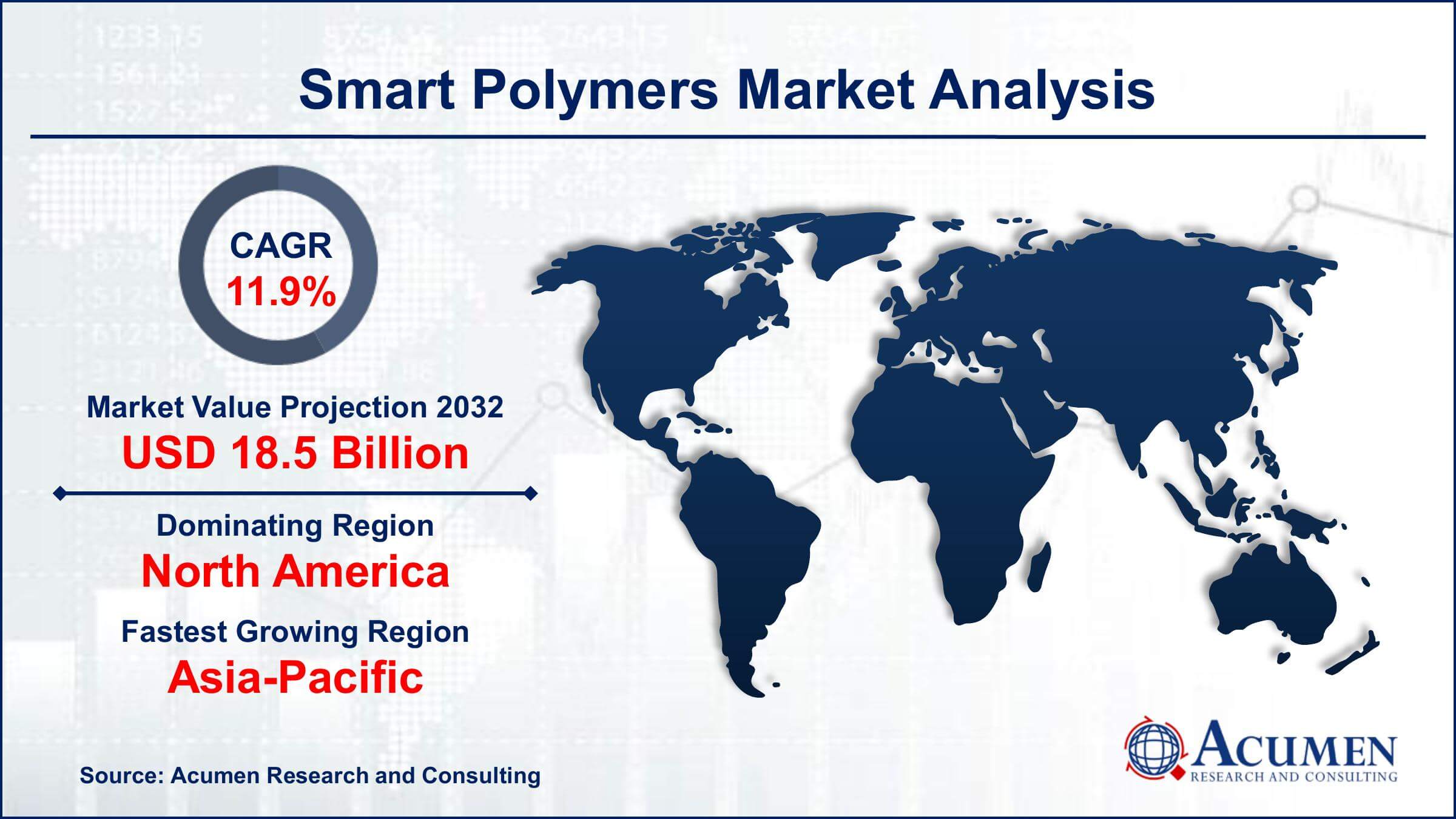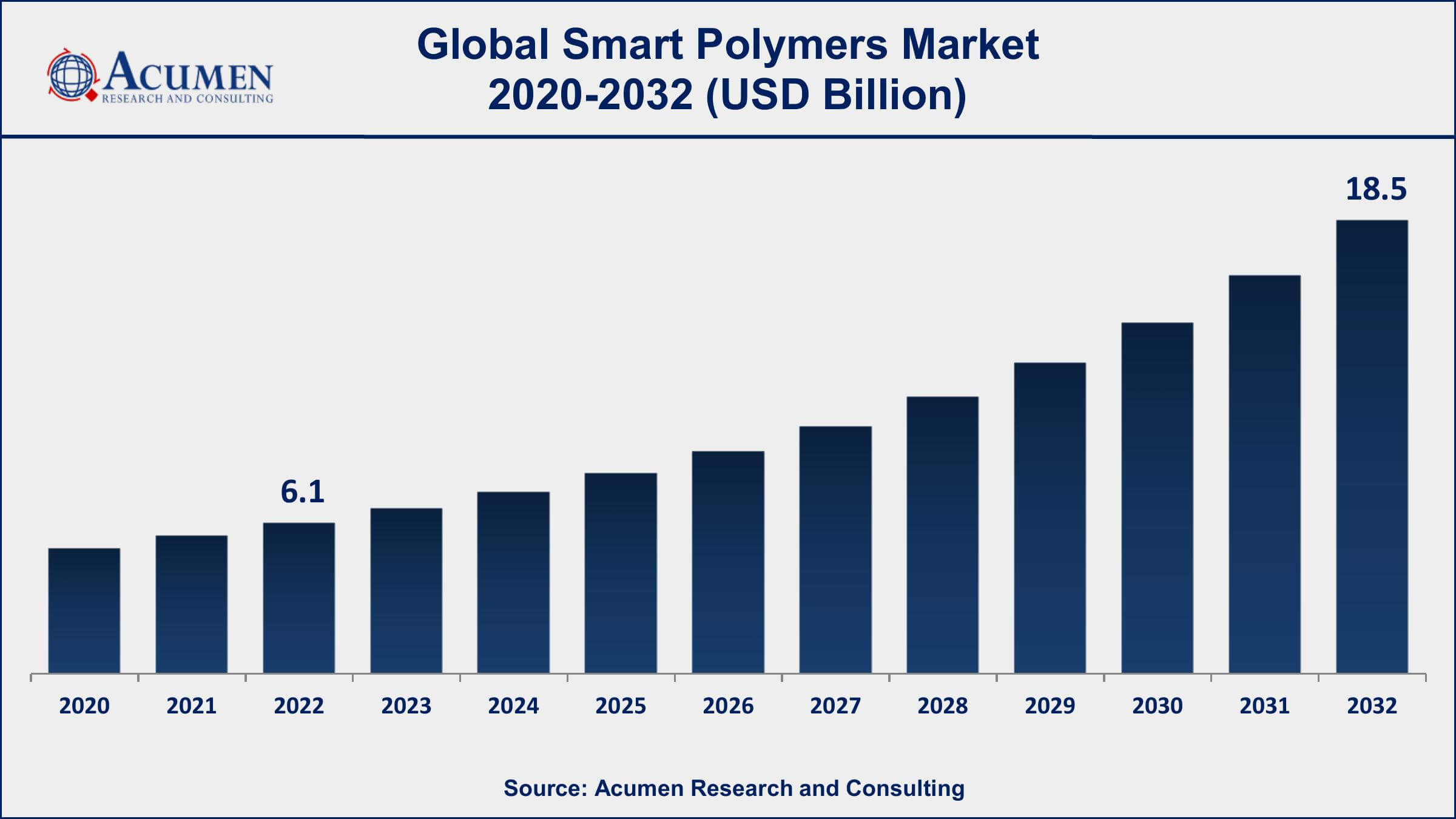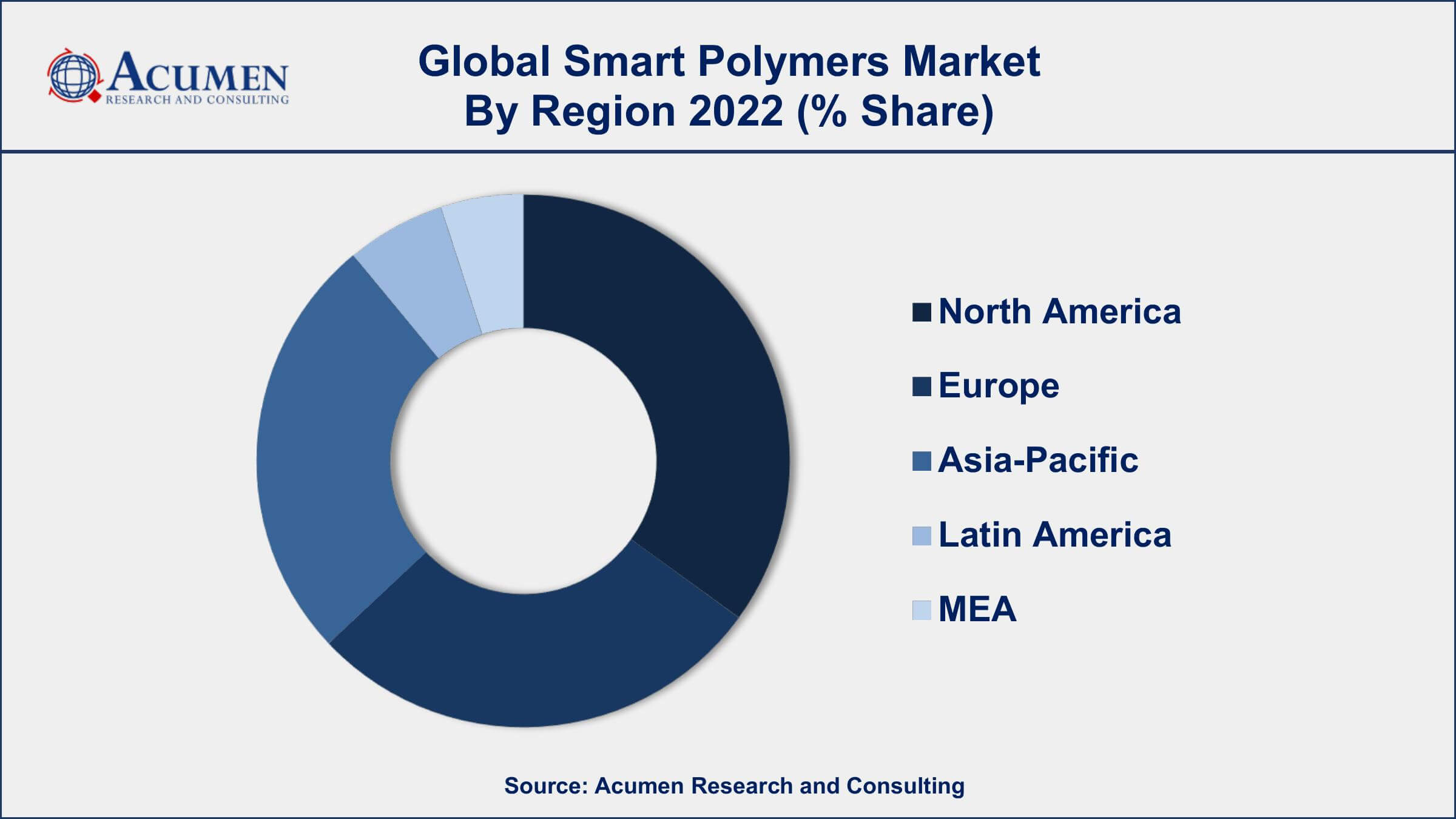January 2019
Smart Polymers Market Size accounted for USD 6.1 Billion in 2022 and is projected to achieve a market size of USD 18.5 Billion by 2032 growing at a CAGR of 11.9% from 2023 to 2032.
The Global Smart Polymers Market Size accounted for USD 6.1 Billion in 2022 and is projected to achieve a market size of USD 18.5 Billion by 2032 growing at a CAGR of 11.9% from 2023 to 2032.
Smart Polymers Market Highlights

Smart polymers, also known as stimuli-responsive polymers, are a class of materials that have the ability to change their physical properties in response to external stimuli such as temperature, pH, light, or magnetic fields. These materials have a wide range of applications in various fields such as biomedical engineering, drug delivery, tissue engineering, and smart textiles. Smart polymers can be designed to respond to specific stimuli and can be tailored to meet specific requirements, making them highly versatile materials.
The market for smart polymers has been growing rapidly over the past few years and is expected to continue to grow in the coming years. The increasing demand for these materials in the healthcare industry for drug delivery systems and tissue engineering applications is a major driver of market growth. In addition, the increasing use of smart polymers in the development of smart textiles for various applications such as sports, military, and fashion is also contributing to the growth of the market. Furthermore, the development of new and innovative smart polymers with advanced functionalities is expected to open up new opportunities for market growth in the future.

Global Smart Polymers Market Trends
Market Drivers
Market Restraints
Market Opportunities
Smart Polymers Market Report Coverage
| Market | Smart Polymers Market |
| Smart Polymers Market Size 2022 | USD 6.1 Billion |
| Smart Polymers Market Forecast 2032 | USD 18.5 Billion |
| Smart Polymers Market CAGR During 2023 - 2032 | 11.9% |
| Smart Polymers Market Analysis Period | 2020 - 2032 |
| Smart Polymers Market Base Year | 2022 |
| Smart Polymers Market Forecast Data | 2023 - 2032 |
| Segments Covered | By Type, By End-user Industry, And By Geography |
| Regional Scope | North America, Europe, Asia Pacific, Latin America, and Middle East & Africa |
| Key Companies Profiled | BASF SE, Covestro AG, Dow Chemical Company, LG Chem Ltd., NIPPON SHOKUBAI CO., LTD., DuPont de Nemours, Inc., Arkema Group, Evonik Industries AG, 3M Company, Mitsubishi Chemical Corporation, Kuraray Co., Ltd., and W. R. Grace & Co. |
| Report Coverage |
Market Trends, Drivers, Restraints, Competitive Analysis, Player Profiling, Covid-19 Analysis, Regulation Analysis |
Smart polymers, also known as stimuli-responsive polymers, are materials that can change their physical properties in response to external stimuli such as temperature, pH, light, or magnetic fields. These materials are highly versatile and can be designed to respond to specific stimuli, making them useful in a wide range of applications. One major application of smart polymers is in drug delivery. Smart polymers can be designed to release drugs in a controlled manner, which can improve efficacy and reduce the side effects of the drugs. For example, a smart polymer can be designed to release a drug in response to a specific pH level in the body, such as the acidic environment in tumor cells.
The smart polymers market has been experiencing significant growth over the past few years, and this trend is expected to continue in the coming years. The market for smart polymers is being driven by increasing demand for advanced materials with specific properties and functionalities in various industries. In particular, the healthcare industry has emerged as a major driver of market growth, with the growing use of smart polymers in drug delivery and tissue engineering applications. The smart textiles industry is another key market for smart polymers, with growing demand for these materials in various applications such as sports, military, and fashion. In addition, the development of new and innovative smart polymers with advanced functionalities and properties is expected to open up new opportunities for the smart polymers market growth.
Smart Polymers Market Segmentation
The global smart polymers market segmentation is based on type, end-user industry, and geography.
Smart Polymers Market By Type
In terms of types, the physical stimuli-responsive segment has seen significant growth in recent years. Physical stimuli-responsive smart polymers, which include temperature-responsive, pH-responsive, and light-responsive polymers, are a key segment of the market. These materials have the ability to change their physical properties in response to external stimuli such as temperature, pH, and light, and are widely used in various applications such as drug delivery, tissue engineering, and smart textiles. The physical stimuli-responsive segment is expected to grow at a significant rate over the next few years, driven by increasing demand for these materials in the healthcare industry. Temperature-responsive polymers, in particular, are expected to see strong growth, owing to their ability to control drug release rates and target specific tissues in the body. The light-responsive segment is also expected to grow at a significant rate, owing to the growing use of these materials in smart textile applications such as light-responsive clothing and accessories. In addition, the pH-responsive segment is expected to see strong growth, owing to its use in drug delivery systems and tissue engineering applications.
Smart Polymers Market By End-user Industry
According to the smart polymers market forecast, the biomedical and healthcare segment is expected to witness significant growth in the coming years. Smart polymers are widely used in the development of drug delivery systems, tissue engineering, and medical implants, owing to their ability to respond to specific stimuli and deliver drugs or promote tissue regeneration in a targeted and controlled manner. The use of smart polymers in drug delivery systems is expected to be a major driver of growth in the biomedical and healthcare segment. Smart polymers can be designed to release drugs in response to specific stimuli such as temperature, pH, or light, providing a targeted and controlled release of drugs with reduced side effects. In addition, the use of smart polymers in tissue engineering applications is also expected to drive growth in the biomedical and healthcare segment of the market. Smart polymers can be used to create scaffolds for tissue regeneration, providing a three-dimensional structure for cells to grow and develop in a controlled environment.
Smart Polymers Market Regional Outlook
North America
Europe
Asia-Pacific
Latin America
The Middle East & Africa

Smart Polymers Market Regional Analysis
North America is currently the largest market for smart polymers, accounting for a significant share of the global market. There are several factors driving the dominance of North America in the smart polymers market. One of the key factors is the presence of a well-established healthcare industry in the region. The use of smart polymers in drug delivery and tissue engineering applications is particularly high in the North American healthcare industry, driving demand for these materials. In addition, there is a high level of investment in the research and development of new and innovative smart polymers in North America. The region is home to several leading universities and research institutions that are actively engaged in the development of advanced materials, including smart polymers. Moreover, the region is also home to several leading manufacturers of smart polymers, providing a strong supply chain for the development and commercialization of these materials. The presence of a large number of textile manufacturers in the region has also driven the demand for smart polymers in the development of smart textiles.
Smart Polymers Market Player
Some of the top smart polymers market companies offered in the professional report include BASF SE, Covestro AG, Dow Chemical Company, LG Chem Ltd., NIPPON SHOKUBAI CO., LTD., DuPont de Nemours, Inc., Arkema Group, Evonik Industries AG, 3M Company, Mitsubishi Chemical Corporation, Kuraray Co., Ltd., and W. R. Grace & Co.
Looking for discounts, bulk pricing, or custom solutions? Contact us today at sales@acumenresearchandconsulting.com
January 2019
August 2018
December 2024
December 2024